What Does SEO Mean and What is It?
The acronym SEO stands for search engine optimization.
When people search for anything on Google (www.google.com), it “crawls” the internet to find you the best results. To find and rank these results, Google accounts for SEO.
Optimizing SEO on websites is a digital marketing strategy that’s used to increase quality and quantity of visits to web pages. Prioritizing SEO means you have the strongest chance to rank for searches relevant to your product or service.
Goal: The more you rank, the higher your page sits and the more likely you’ll reach your target audience.
(A major factor to consider is that search engine optimization is about ranking the highest for unpaid results from a keyword search. When you rank without paying for the top spot, it’s organic.)
Before diving into all things SEO, let’s recap:
- It’s about the quality of traffic. Ideally, your site attracts visitors who are genuinely interested in your product or service. These visitors fill out a form, convert, and become leads. Leads become sales. Most of the time, however, your site will attract visitors who are just stopping by for information. Every click is not a sale, and that’s OK! Part of your marketing strategy should be to educate.
- But it’s also about the quantity of traffic. Whether your visitors convert or not, it’s still good news. The more people engage with your website over other search engine results, the better. Consistent engagement yields optimal SEO.
- And it’s always about the organic results. Pay-per-click campaigns using Google Ads will send you straight to the top of the page, but that’s not always good for long-term SEO. Organic traffic is more valuable in Google’s algorithm than paid clicks.
What is On-Page SEO?
On-page SEO is also known as onsite SEO.
According to Moz, on-page SEO is the practice of optimizing elements on a website to:
- Achieve high-ranking content
- Funnel relevant web traffic from search engines to your site
- Organize your website’s content and HTML source code
- Help visitors quickly understand what your page is about and whether it’s relevant to their search
Moz (www.moz.com) explains that on-page SEO relies on keywords. Keywords express the relevance of your content and consider user intent when searching. They’re about understanding who your site visitors are and how you can solve their questions and pain points.
(Again, Google penalizes you if you’re always trying to make a sale. Ranking is about providing helpful content.)
Fun fact: On-page SEO is also related to non-keyword concepts. SEO that’s not website copy still influences the user experience, which is the No. 1 ranking factor. The whole of SEO demonstrates that your site is a useful and worthy resource for visitors. To do this, you need to know this industry-changing fact:
Using keywords is important, but it’s not everything.
Search engines are more sophisticated than ever before. Google can determine what you want to get out of a search without matching a query word for word.
It considers more than keywords to give you the best content on the internet. Search engines consider:
- User experience on websites and individual webpages (mobile optimization, page load speed, URL structure/sitemap)
- Properly formatted and sized images and videos
- Scrollability
- External and internal links
- Domain authority
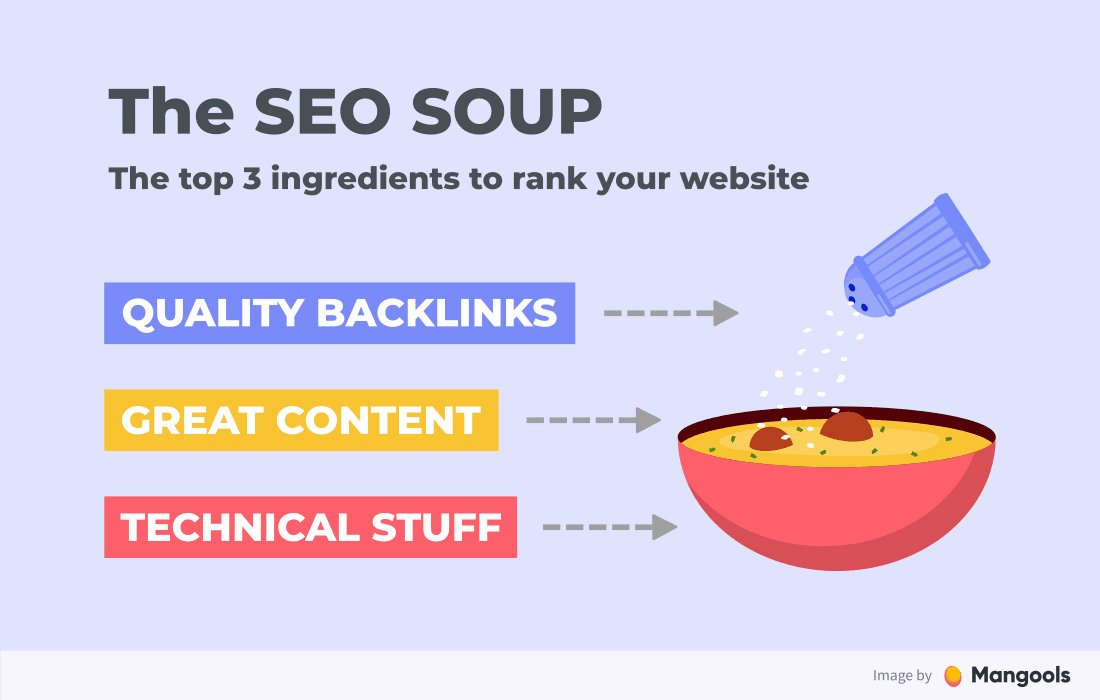

What is Off-Page SEO?
Off-page SEO is also known as offsite SEO. It prioritizes marketing tactics off your website that boost your rankings in search engines.
According to Moz, off-page SEO is shaped by the user’s perception of a site’s popularity, relevance, and authority on a given subject. Quality user perception comes from:
- Repeat website visitors
- Social media engagement
- Guest blogging
- Review websites
- Authoritative backlinks
These factors show Google that you have quality content, because other users trust you enough to source and engage with you.
Even though there’s a difference between on-page SEO and off-page SEO, strong marketing strategies consider both. By prioritizing them equally, you give your website the best chance of ranking higher in search engines.
What is SERP in SEO?
SERP stands for search engine results pages.
They’re the website links that search engines rank in response to a user’s search query. SERP consists of organic and paid results, so the first page includes both. Check out this example for “what is crm” on Google:
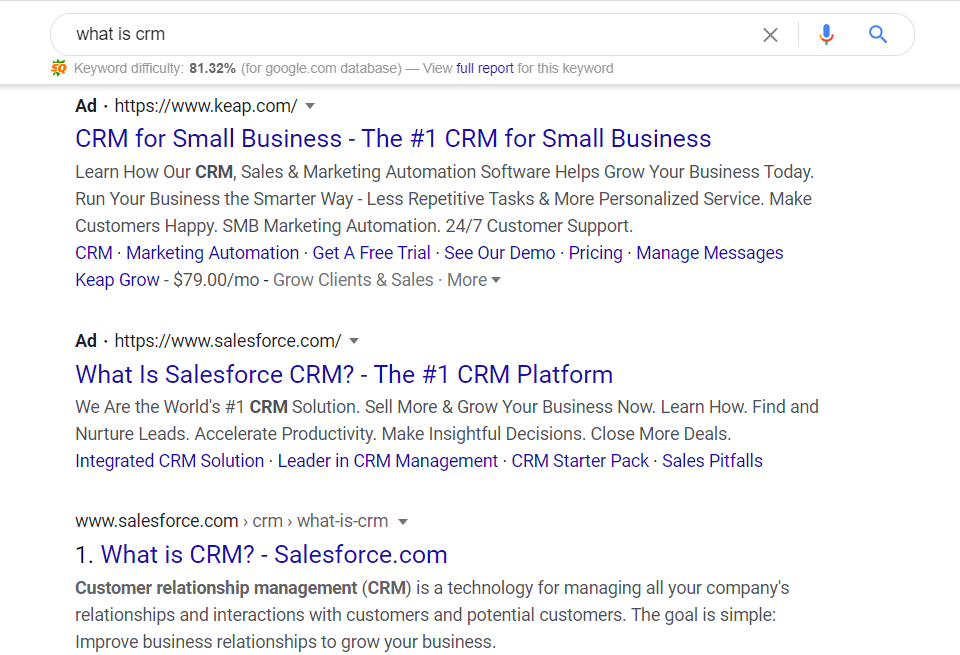

Ad indicates a paid search result. In this example, Keap and Salesforce bid for the top paid spot. 1. indicates the first organic search result, which Salesforce wins with their blog, What is CRM?
Unfortunately, most users never click beyond the first page. According to Ahrefs, approximately 75% of all clicks are between the first three links, which is why it’s crucial to organically rank the highest.
Here’s what you need to know about SERPs:
- Pay-per-click campaigns, also known as paid or PPC campaigns, are physically higher on the page than organic search results.
However, the competition is fierce. Certain keywords cost a lot of money, and the highest bidder always wins. This makes Google Ads expensive for smaller companies, which is why perfecting the ever-changing art of organic SEO is necessary. - Being the top organic result is the goal. This depends on hundreds of features that change with Google’s algorithm updates, but the main SEO factors remain user experience and relevance to a search query.
- It’s controversial if SERP features are the spot to aim for. The upside is the prominent feature on the first page. The downside is they usually directly answer the query without the need to visit a link, so click rates suffer.
You may recognize SERP features as News stories, Shopping links, featured snippets, People Also Ask, Knowledge Panel, Knowledge Card, video playlists, related questions on Quora (www.quora.com), or ratings and reviews.
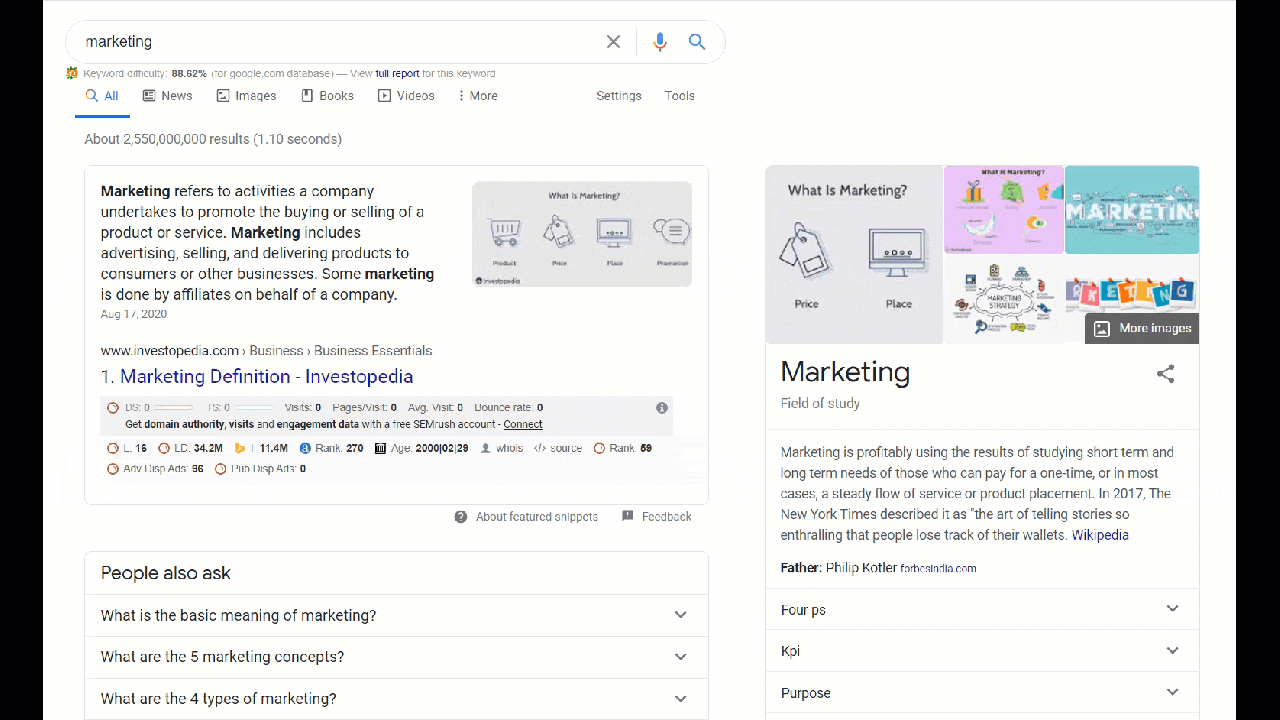

[Tip: Use SERP rank checkers like SERP Checker from Ahrefs, AccuRanker, and Rank Checker to see where you stand among the competition for hot keywords.]
It’s important to remember that it’s harder to rank for SERP features than for organic search results. This is usually because sites with higher domain authority are prioritized in Google’s algorithm, making features easier for bigger brands.
That doesn’t mean you’re out of the game, though! Small but mighty keywords still exist, and, oftentimes, less competitive but more specific keywords increase your chances of ranking high. Look for relevant keywords with a high search volume and a low keyword difficulty.
What is White Hat SEO?
Ahrefs defines white hat SEO as the process of using Google-approved website optimization techniques. The goal of white hat SEO is to provide the user with the best possible search engine results.
White hat SEO techniques include:
- Abiding by Google’s search engine guidelines
- Optimizing results for users, not search engines
- Creating quality content
- Creating a unique, simple, and valuable website
- Using organic link-building techniques
Oppositely, black hat SEO is the villain. They’re “tactics that … get a site higher SERP rankings, but are unethical and violate search engine guidelines.” A few black hat SEO techniques to avoid include keyword stuffing, link farming, and publishing bad content.
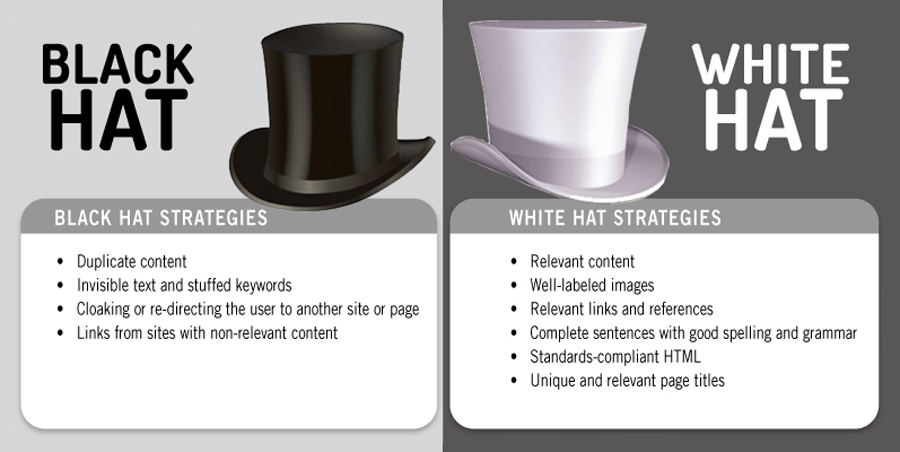

What are SEO Scores?
SEO scores illustrate how the user experience and technical aspects of your site contribute to search engine optimization. Use SEO scores as a vanity measurement of how well your on-page and off-page SEO techniques are doing. Both marketing strategies hold weight in your site’s SEO score and drive clicks.
Looking for an SEO score checker?
Neil Patel (www.neilpatel.com) offers a free SEO score checker. With this tool, you’ll receive an:
- SEO audit of your site
- Analysis of your current onsite SEO techniques
- Audit of your offsite SEO techniques, including backlinks and site speed
What is SEO in Digital Marketing?
We talked about on-page SEO and off-page SEO, the difference between white hat SEO and black hat SEO techniques, and SERP features.
So, how do you add all this information into your marketing campaigns?
It’s not easy, but it’s a key step to optimizing your content and growing your audience. To begin, identify your keywords and integrate them into your website, from blogs to landing pages.
You can also use a handful of free SEO tools to target the right keywords for your product or service:
- Ahrefs Keyword Generator Tool. Ahrefs has a free keyword generator tool that finds keywords across Google, Bing, YouTube, Amazon, Yahoo, and Baidu.
Enter up to ten words or phrases, and your keywords are searched within Ahrefs database of over 8 million queries. This tool even searches keywords in different countries, which is helpful if your target audience is global.
This keyword generator tool determines the search and click volume of your selected keywords and offers research filters to access less commonly used keywords. It also groups your results by topic and long-tail keywords.
If you’re looking to break into specific keywords, you can also see the competition for each keyword per search engine. - Screaming Frog’s SEO Spider Tool. Screaming Frog has a free SEO checker tool for onsite search engine optimization. Explore competitors’ onsite SEO strategies and audit 500 URLs in the free version. This digital marketing tool also identifies broken backlinks, analyzes your website’s titles and metadata, and determines your site’s technical limits.
- Google’s Keyword Planner. This tool helps you strategically develop keywords in paid advertisements to reach your target audience. With this keyword research tool, you’ll find the keywords most relevant to your site and gain insight into how frequently your keywords are searched, down to the time of day.
A unique feature of this Google tool is you can save the most relevant keywords for a customized advertising plan.
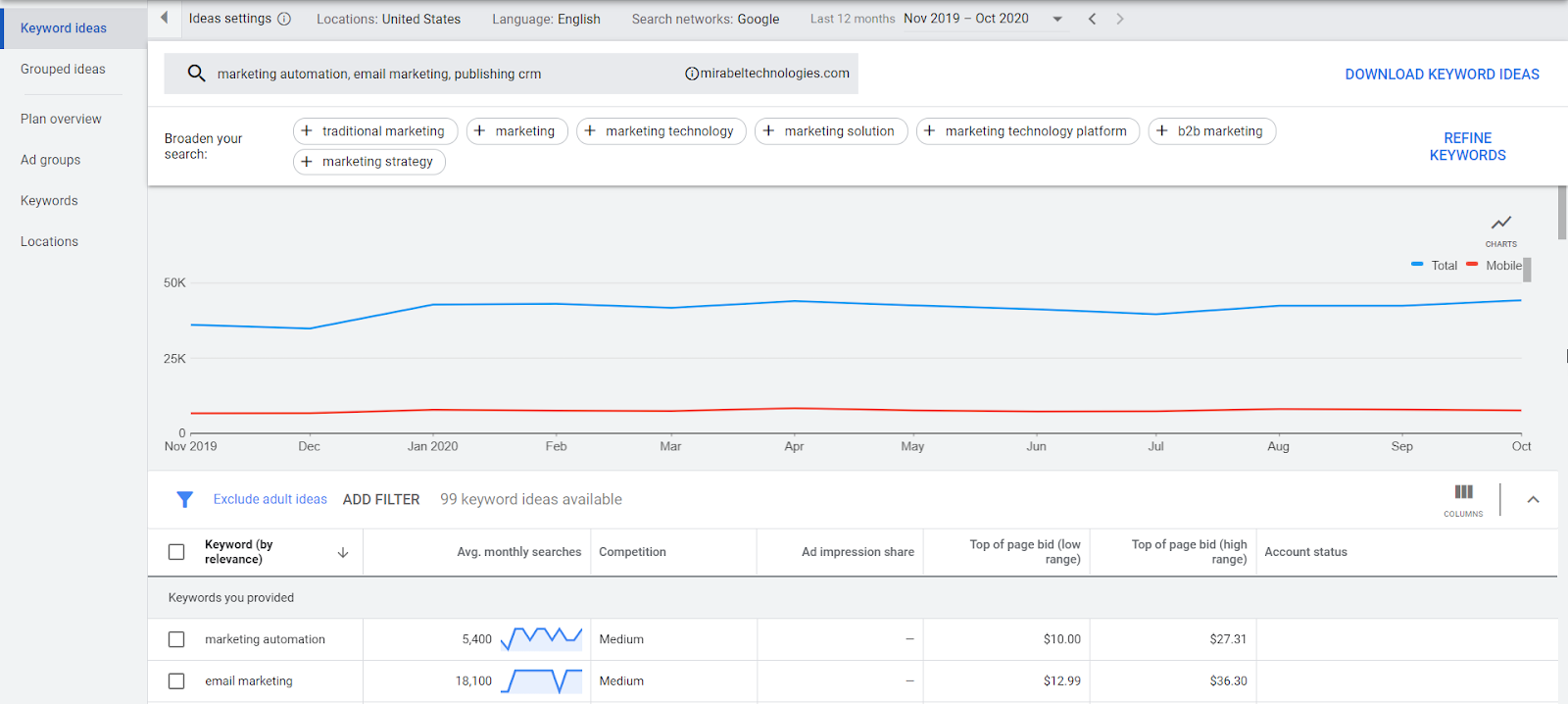

Remember: Don’t underestimate less powerful keywords, particularly long-tail keywords. These keywords typically have a low search volume and target more specific pain points.
Keyword optimization strategies are largely dependent on discovering these high-value keywords. Long-tail keywords hold intention and direct answers to your target audience’s search queries, which is a white hat SEO technique. Researching regional keywords and technical jargon are also effective SEO strategies.
Keywords are most most effective when developed around these three questions:
- What are users searching for?
- How popular are the terms they’re using?
- How do users want this information presented to them?
What is the Difference Between SEO and SEM?
While SEO is all about organic ranking, SEM (search engine marketing) is about paid ranking. As demonstrated above, paid spots are placed above organic results.
According to HubSpot, SEM ensures that your content is optimized for higher rankings on SERPs. It’s directed to digital audiences who are most interested in your content.
On the other hand, a site with a strong SEO strategy also has a higher chance of ranking high on paid searches.
SEO and SEM are distinct, yet, complementary approaches. Ideally, your marketing strategy will involve a combination of the two.
Determining how to incorporate each strategy in your digital marketing campaign depends on the goals of your campaign. Evaluate the rate at which your business is growing and the costs it’ll take to do SEO and SEM properly, armed with all this helpful information.
SEE FOR YOURSELF
Watch an overview to learn how B2B marketing automation by Mirabel Technologies can help you increase traffic, optimize your funnel, drive more leads, improve conversions, and boost ROI — at a price you can afford!

